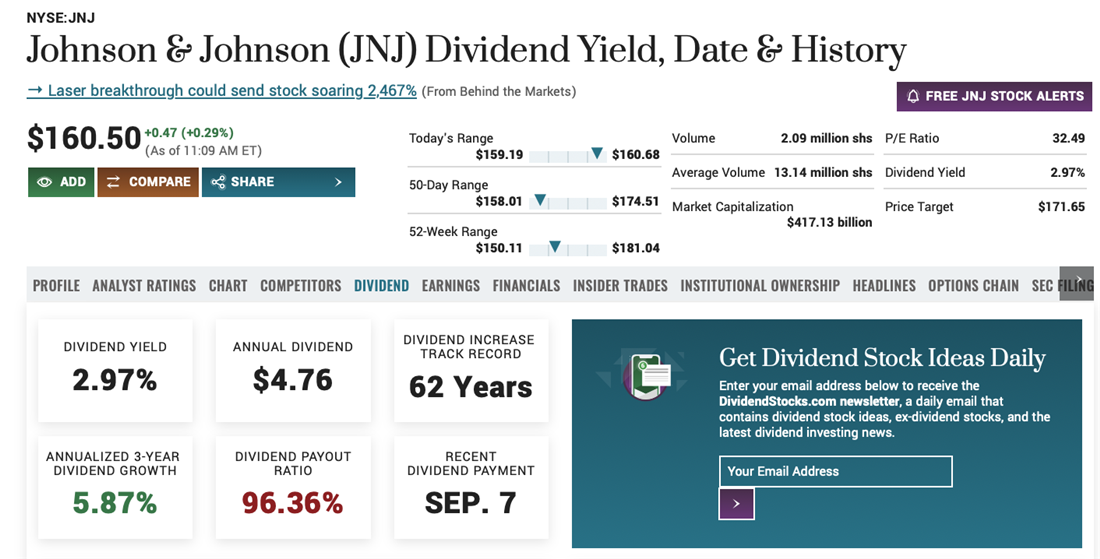Key Points
- Dividend growth rates are a key indicator of whether a company is financially healthy.
- A dividend growth rate measures a company’s ability to increase the dividends it pays to shareholders over time.
- You can use dividend growth rates to determine whether your investment is worth making or holding.

If you seek regular income, you know that dividends are a must-have. Likewise, dividend growth rates are a key indicator of whether a company is financially healthy enough to keep paying them. You can use dividend growth rates to determine whether your investment is worth making or holding.
By calculating dividend growth rates, you have another tool in your arsenal to make the most informed investment decision possible. In this article, we’ll discuss dividend growth rates, why they’re important and how to calculate them.
What is a Dividend Growth Rate?
A dividend growth rate measures a company’s ability to increase the dividends it pays to shareholders over time. You can express this rate as a percentage by comparing the current dividend per share to the dividend per share from the previous period.
High Dividend Growth Rates
A high dividend growth rate (such as those on MarketBeat's top-rated dividend stock list) indicates that the company has increased its dividend payments over time, which is often a sign of financial health.
Suppose a stock has a high dividend growth rate. In that case, it may indicate that the company will continue paying out larger dividends in subsequent periods. You can expect your income stream from the stock to rise accordingly. Generally, companies with higher payout ratios tend to have more stable share prices and a better capacity for returning funds to their shareholders, which is especially true when the company in question pays out so much of its profits as dividends that it has little choice but to continue rewarding its investors.
This makes it a solid choice if you crave assurance and reliability or want an income stream you can trust. High dividend growth rates may also signal the potential for capital appreciation over time; if a stock’s dividends are increasing at regular intervals, its earnings might be growing, too, providing room for capital gains down the track.
Low Dividend Growth Rates
On the other hand, a low dividend growth rate can indicate financial distress. If a company is not continually increasing its dividend payments, it could mean that its business is struggling and cannot generate enough cash flow from operations to support these increases.
In addition, companies with low or declining dividends may have difficulty attracting investors due to a perceived lack of stability in their underlying operations. This could result in decreased value for existing shareholders over time. As such, many investors view this warning sign as reason enough to avoid investing in the stock altogether.
Why Are Dividend Growth Rates Important?
Dividend growth rates can determine whether a company is a good investment. Companies with a high dividend growth rate might be more financially sound than those without because they're consistently increasing their dividend payments, which means they generate more cash flow from their operations.
You can also use a company’s dividend growth rate to predict future dividend payments, especially if you want to make long-term investments. By calculating the dividend growth rate, you can estimate how much money you can expect to receive from a particular company.
How to Calculate Dividend Growth Rates
There are a few different methods for calculating dividend growth rates, including using MarketBeat's dividend calculator. The simplest way to do it is to take the current dividend per share and divide it by the dividend per share from the previous period. This will give you the dividend growth rate for that period.
For example, if a company’s current dividend per share is $1.00 and the previous dividend per share was 50 cents, the dividend growth rate would be 100 percent. This means the company’s dividend payments have doubled over the period.
Another way to calculate dividend growth rates is to calculate the compound annual growth rate (CAGR). This method takes into account the dividend growth rates over multiple periods. To calculate CAGR, just divide the current dividend per share by the dividend per share from the beginning of the period. Then, you take the result and raise it to the power of one divided by the number of periods.
For example, if a company has increased its dividend per share from 50 cents to $1 over three years, you would divide $1 by $0.50 and then raise the answer to the power of one-third (since there were three years), giving you a compound annual growth rate (CAGR) of 8.2%.
Example of a Stock with a Good Dividend Growth Rate
Johnson & Johnson (NYSE: JNJ) is a great example of a stock with a good dividend growth rate. Johnson & Johnson has increased its dividends every year since 1963. The company has consistently increased its dividends yearly, often a sign of financial health.
Furthermore, J&J's dividend yield (dividends divided by the share price) is higher than the average for the S&P 500 Index. These factors make J&J an attractive investment if you're looking for reliable dividend income.

What is an Average Dividend Growth Rate?
An average dividend growth rate is 8% to 10%. However, this can vary greatly among different stocks and industries. Companies with a steady history of dividend increases outperforming their peers may have a higher-than-average dividend growth rate.
Generally speaking, above-average dividend growth rates would be considered 10% or higher. Looking at the company's track record of dividend increases over time can be useful in predicting how much they will grow dividends in the future. But, dividend growth rates may fluctuate over time, so you should assess any changes in the rate with caution. Research the industry and identify companies with positive outlooks and strong management teams. This could also lead to finding stocks with higher-than-average dividend growth rates.
Dividend Growth Rates vs. Other Financial Metrics
Dividend growth rates are useful for measuring a company’s financial health and predicting future dividend payments. But they’re not the only metrics to consider. Here are some other metrics to look at when evaluating whether a company might be a good investment.
Stock Growth Rates
Stock growth rates measure the increase in the price of a company’s stock over time. A high stock growth rate is usually a positive indicator, meaning investors believe the company is doing well and will continue to do well. You can also use stock growth rates to compare companies within the same sector or industry.
Dividend Yields
Dividend yields measure how much income an investor receives from dividends relative to their investment in the stock. You can calculate the dividend yield by dividing the annual dividend per share by the stock's current market price. You might want to invest in companies with higher dividend yields, as they provide more income. But remember that higher dividend yields don't always mean better returns on investment. Other factors could be at play, such as taxes or inflation, that may offset any gains you see from higher yields.
How to Choose a Stock Based on Dividend Growth Rates
When selecting stocks as an income investor, there are several key criteria that you should consider, and one of the most important is the dividend growth rate.
Since this rate measures how much a company’s dividend payment will likely increase over time, companies with higher dividend growth rates often indicate strong corporate cash flows and better stock performance. But this rate isn't the only one you should use. Look at other factors, such as the company’s payout ratio, debt-to-equity ratio and management team, to gauge a company’s prospects more accurately.
Other Criteria to Consider
In addition to dividend growth rate, look at other criteria such as earnings per share (EPS), price/earnings ratio (P/E), return on equity (ROE), current yield and sector performance. EPS measures how profitable a company is per share, while P/E tells you what you're paying for each dollar of earnings.
Both metrics help determine how valuable a stock may be. Meanwhile, ROE tells you how effectively management uses their invested capital. The current yield of a stock indicates the potential income you might get. Finally, sector performance helps provide context for how well a particular industry may be doing overall, especially if you're trying to decide to dive into one industry versus another.
High Dividend Growth Rates Could Mean Good Income for You
Dividend growth rates are an important indicator of a company’s financial health. You can use them to determine whether or not an investment is worth making. There are several different methods for calculating dividend growth rates, including simple and compound annual growth rates. But whichever method you choose, take time to understand and calculate dividend growth rates so you can go into your investments with your eyes wide open.
Get Income-Generating Stocks Like Johnson & Johnson in Your Inbox.
Stop riding the roller coaster of the stock market and sign-up to receive DividendStocks.com's daily ex-dividend stocks and dividend investing news for JNJ and related companies.
Companies Mentioned in This Article:| Company | Current Price | Price Change | Dividend Yield | P/E Ratio | Consensus Rating | Consensus Price Target |
|---|
| Johnson & Johnson (JNJ) | $164.78 | +6.2% | 3.16% | 18.33 | Moderate Buy | $171.00 |
About Claire Shefchik
Experience
Claire Shefchik has been a contributing writer for DividendStocks.com since 2023.
Areas of Expertise
Finance, business
Education
Bachelor of Arts in Writing, University of Arizona; Master of Fine Arts in Writing, Sarah Lawrence College
Past Experience
Business editor, BVI Beacon, senior writer, Business BVI